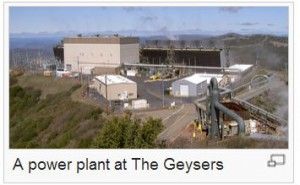CA geothermal power dreams appear dashed
by Chris Reed | August 2, 2015 9:58 am
 Geothermal power had a huge year in 2014 — in Kenya, Turkey, Ethiopia and Germany. But in all of the U.S., according to a Geothermal Energy Association report[1], total power generated by geothermal was less then 3 gigawatts for the year in a nation that used more than 4,000 terawatts (400,000 gigawatts).
Geothermal power had a huge year in 2014 — in Kenya, Turkey, Ethiopia and Germany. But in all of the U.S., according to a Geothermal Energy Association report[1], total power generated by geothermal was less then 3 gigawatts for the year in a nation that used more than 4,000 terawatts (400,000 gigawatts).
However, California’s emphasis on switching to renewable power — and the little-known fact that it is home to The Geysers[2], the world’s largest geothermal power complex, 70 miles north of San Francisco — has officials in Imperial County hopeful that developing their region’s vast geothermal resource can be part of a larger overall plan to rescue the dying Salton Sea and improve the impoverished local economy.
Last year, working with the Imperial Irrigation District, state Sen. Ben Hueso, a Democrat from San Diego whose district includes all of Imperial County, and Assemblyman V. Manuel Pérez, D-Coachella, won Senate passage of SB 1139 before pulling the bill from Assembly consideration in September. This is from the Desert Sun’s account[3]:
SB 1139 … would require utilities to buy 500 megawatts of electricity from new geothermal plants by 2024 … . While the bill wouldn’t have required that any geothermal power come from the Salton Sea specifically, it’s likely that developers would have jumped to take advantage of the sea’s huge untapped energy potential.
IID has estimated that geothermal and other green technology development at the Salton Sea could generate more than $4 billion over 30 years, with much of that money going toward restoring the receding body of water. Ramping up geothermal development would also create thousands of jobs in Imperial County, which has a 22 percent unemployment rate[4] — the highest in the state.
It’s unclear why [Hueso and Pérez] decided not to bring the bill to a vote in the Assembly, following its 21-11 passage in the Senate earlier this year. Hueso’s office had indicated last month it was only a matter of time before the bill came up for a vote in the Assembly, but it’s possible he simply didn’t have enough votes to secure its passage.
Imperial still committed to grand plans
As saltonseasense.com noted[5] in June, quoting official reports, the Imperial Irrigation District remains committed “to build up to 1,700 MW of geothermal power by the early 2030s at the Salton Sea.”
But it’s no longer clear if there is much legislative support for an SB 1139-type approach mandating geothermal development. Officials with the state’s three giant investor-owned utilities have never been big fans of geothermal as a major source of state power. Energy experts say there’s a reason that there’s no billionaire enthusiast pushing geothermal, as T. Boone Pickens has done[6] with wind power and several tycoons have done with solar power. It’s because a deep dig into the facts — by scientists as well as potential investors — shows it’s not an attractive option.
Tom Murphy, an associate professor of physics at the University of California-San Diego, explains why on his “Do the Math” blog[7]:
The energy derived is mostly useful for heat, being inefficient at producing electricity. It won’t fly our planes or drive our cars. And it’s buried under kilometers of solid rock, making it very difficult to access. Each borehole only makes available the heat in its immediate surroundings — unlike drilling for oil or natural gas, where a single hole may access a large underground deposit.
So my guess is that we’ll burn every tree and fossil fuel on the planet before we start drilling through ordinary rock to stay warm. In other words, there is little incentive to dig deep for heat. By the time we run out of the easier resources —having burned every scrap of wood not bolted down — are we going to be left in a state to drill through rock at a massive scale? ….
In short, even though the thermal energy sitting under our feet is enormous in magnitude, it does not strike me as a lucky find. No one is racing to dig in. Perhaps it is simpler to say that it’s economically excluded, at present.
The 10 small geothermal plants now operating[8] in Imperial County are seen as a promising symbol of what the poor farming region might become. But the reality seems much more likely to be that geothermal energy — on a large scale, at least — never amounts to much in a California that’s now rushing to invent its alternative-energy future.
Instead, those plants could someday be seen as a symbol of the folly of local politicians and bureaucrats talking themselves into believing that they could treat geothermal energy production as if it were a type of pork that could be legislated into existence.
- report: http://geo-energy.org/events/2014%20Annual%20US%20&%20Global%20Geothermal%20Power%20Production%20Report%20Final.pdf
- The Geysers: http://www.geysers.com/geothermal.aspx
- account: http://www.desertsun.com/story/news/2014/09/02/tesla-deal-geothermal-bill-fail-advance-calif/14994555/
- unemployment rate: http://data.bls.gov/map/MapToolServlet
- noted: http://saltonseasense.com/2015/05/27/a-treasure-buried-underground/#_edn3
- has done: http://www.pickensplan.com/the-plan/wind/
- blog: http://physics.ucsd.edu/do-the-math/2012/01/warm-and-fuzzy-on-geothermal/
- operating: http://energy.gov/eere/geothermal/imperial-valley-geothermal-area
Source URL: https://calwatchdog.com/2015/08/02/ca-geothermal-power-dreams-appear-dashed/